Ask Ethan: How Can We Tell If An Exoplanet Has A Surface?

Whether they’re gas giants or rocky planets makes all the difference for life.
Over the past 30 years, we went from not knowing if there were planets like ours around other stars to a catalogue containing thousands of them. Today, we know of over 4,000 confirmed exoplanets, with a few of them even possessing properties that we assume might be friendly to life. However, the most “typical” planet found by NASA’s Kepler mission isn’t exactly like anything found in our Solar System, but rather has a mass and size somewhere in between the size of Earth and Neptune. Are they more like Earth, with surfaces and thin atmospheres, or like Neptune, with large, volatile gas envelopes? That’s the burning question on Dr. Xinting Yu, a postdoctoral fellow at UC Santa Cruz, who writes in to suggest a new way of looking at a longstanding problem:
“We are publishing a new article on detecting solid surfaces or liquid oceans on exoplanets… none of the upcoming space telescopes have the capacity to “see” the surface of the exoplanet directly, but they are excellent at seeing the atmospheric composition. I am sending you this paper in case you are interested!”
I did take a look, and not only am I interested, but I think everyone will be really excited about this upcoming technique that might, for the first time, tell us which exoplanets in the so-called “super-Earth” category really do have surfaces, rather than volatile gas envelopes. Here’s how.
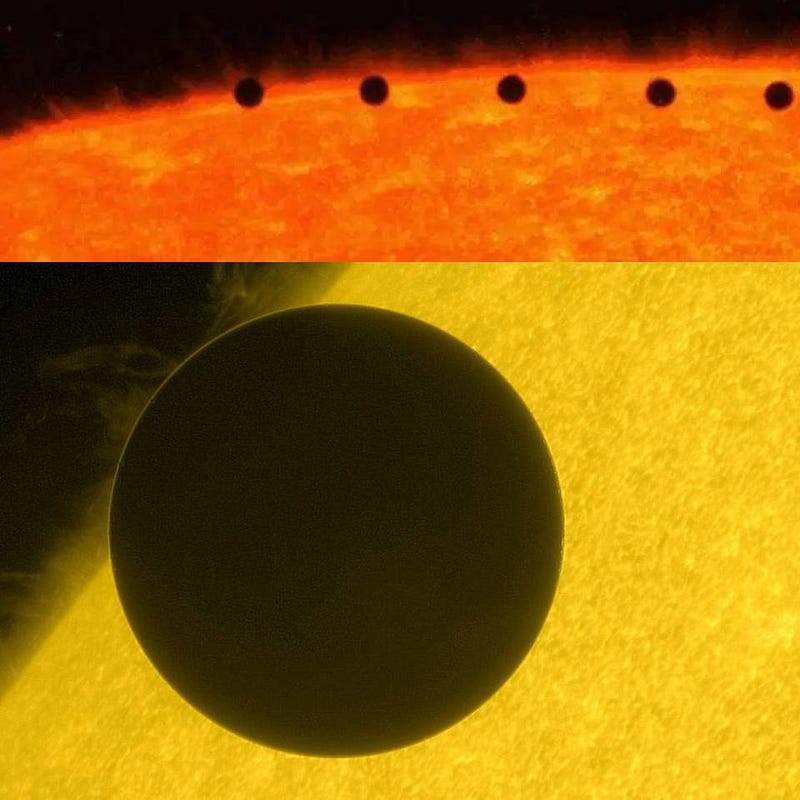
The problem is as follows. The way we’ve discovered the overwhelming majority of our exoplanets — the planets found in space that orbit stars beyond our Sun — is through the transit method. You can imagine two possibilities for what it would look like to watch the planets orbit our Sun from far away:
- either we see the planets orbit the Sun at a sufficiently large angle so that they never crossed in front of or ducked behind the Sun from our perspective,
- or the orientation of the planetary orbits would be almost, or even perfectly, edge-on, so that some, or possibly even all of the planets, eventually and periodically crossed in front of or ducked behind the Sun.
That second option is rare, of course. But given that NASA’s Kepler mission was watching the same patch of sky, viewing over 100,000 stars at once for a period of ~3 years during its primary mission, it’s no surprise that we would up revealing thousands of stars with planets around them. Not only that, but many of those stars had multiple planets, with one system (at least) containing at least as many as our own, with eight discovered so far.
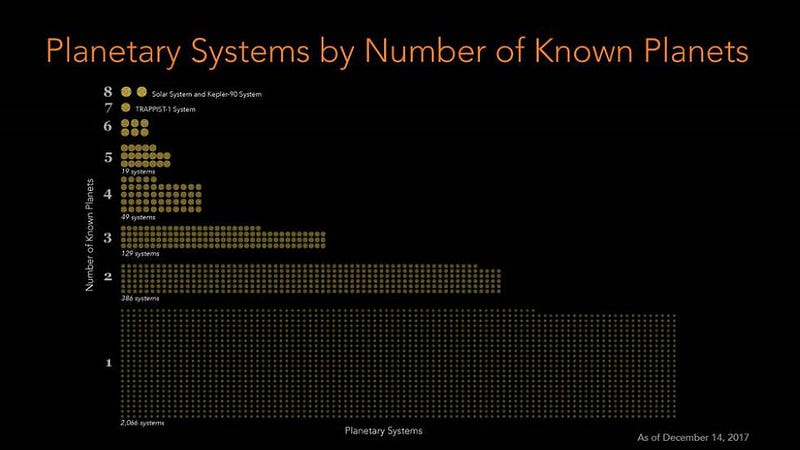
From the transit method, a fraction of the star’s light will be blocked periodically by the planet: every time the planet passes in front of the star’s disk. Because astronomers understand how both stars and gravitation work, we can infer the physical size (like the radius) of the planet, as well as its orbital properties as it revolves around its parent star.
If we then follow up our transit observations with a radial velocity study — where we measure how the star gently appears to periodically move towards us, then become stationary, then move away from us, then become stationary, then towards us again, etc. — we can even learn the mass of the orbiting planet. With those three pieces of data:
- the mass of the planet,
- the size of the planet,
- and the orbital distance of the planet from the star,
we can start to think about the most burning question that astronomers who study these exoplanets have in their minds: which of these planets, if any, might be suitable for life? And, if we’re very, very lucky, might any of them actually be inhabited?
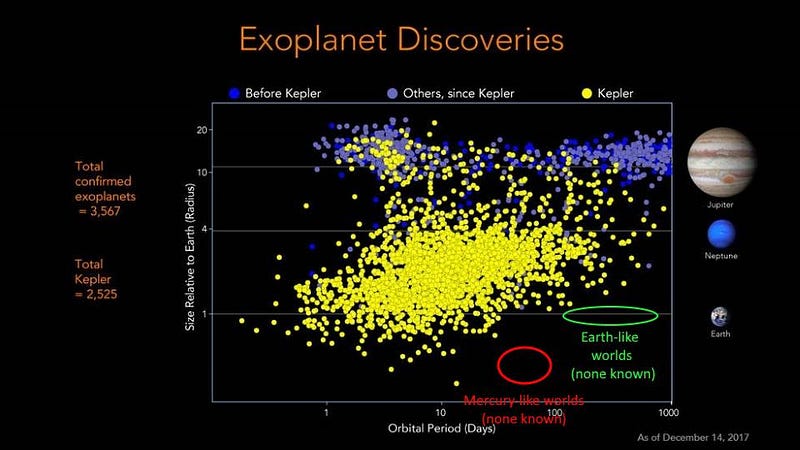
We know, from both our own Solar System and the observations we’ve made around other stars, that some exoplanets are very, very likely to be rocky planets similar to the ones we find in our own neighborhood: Earth, Venus, Mars, and Mercury. They might be airless like Mercury, have very thin atmospheres like Mars, have life-and-water-friendly atmospheres like Earth, or have substantial, but not gas giant-like, atmospheres like Venus.
We’ve seen, based on the densities of many worlds, that the overwhelming majority of planets with masses below 2 Earth masses and radii below about ~1.2 Earth radii are, in fact, rocky like the ones in our own backyard.
Similarly, we can tell with a large degree of certainty that if you have more than about 10 Earth masses, or more than about ~2 Earth radii, you’re almost certainly going to be more like Uranus or Neptune: holding on to a large, massive envelope of hydrogen and helium gases. There’s probably a surface somewhere down there, but you’d have to go down below more than ~1000 times the atmosphere currently present on Earth, rendering you more like a gas giant.
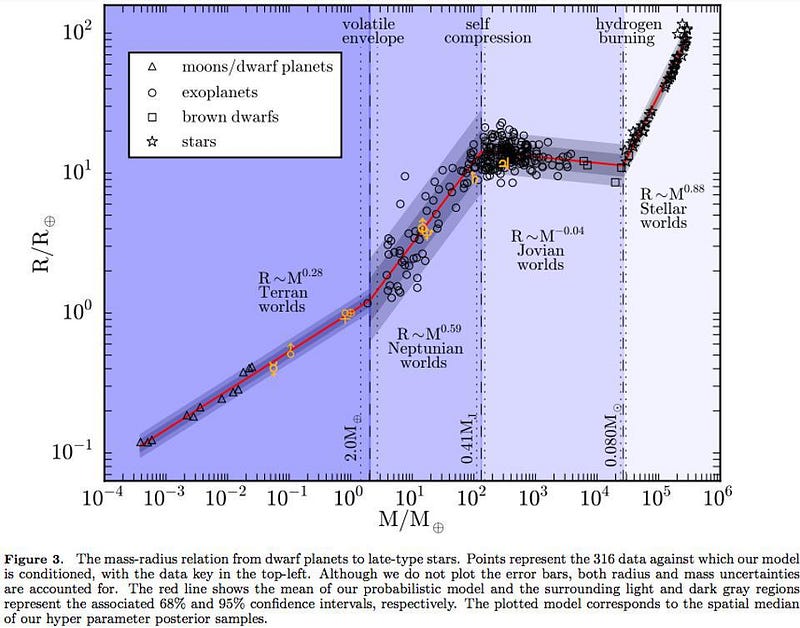
Somewhere, larger than Earth but smaller than Neptune, is a transition point, where planets, on average, are no longer able to maintain a thin atmosphere with a potentially habitable surface beneath them, and instead successfully hang onto the volatile gases that were around during the early phases of the Solar System. Knowing which worlds are rocky, with thin atmospheres, is an important key to identifying the first worlds beyond our Solar System to search for extraterrestrial life.
The problem is that, despite all our advances in finding, characterizing, and understanding exoplanets, there are still relatively few of them that are small enough and low enough in mass to definitely be rocky. Moreover, even a smaller subset of those are likely to be habitable, as most of them are either too hot or too cold to potentially house liquid water on their surfaces.
However, what we presently call super-Earth planets are actually the most common type of exoplanet found by NASA’s Kepler mission. If some, most, or all of these in-between planets actually turn out to have solid surfaces with thin atmospheres, they could revolutionize the search for life beyond Earth.

In an ideal world, we’d have a telescope that was capable of directly imaging these exoplanets: seeing and measuring their own emitted/reflected light directly. If we had a large enough, sensitive enough telescope that could successfully block out enough of the parent star’s light while still letting the orbiting planet’s light through, it would give us a wonderful way to answer that question directly. Even if an exoplanet only showed up as a single pixel in our telescopes, that point of light would change in important ways over time. With enough data, we could infer:
- how quickly the planet rotated on its axis,
- whether it had total or partial cloud cover and what the composition of those clouds was,
- whether it had continents and liquid oceans and what fraction of the world was covered in water,
- whether it had polar icecaps that grew and shrank with the seasons, teaching us about the planetary climate,
- whether the colors of the continents greened-and-browned, or otherwise changed with the periodic seasons,
and many other fascinating pieces of data. Unfortunately, we do not yet know whether the one telescope that’s been proposed that’s capable of making those observations — NASA’s concept flagship mission currently under review, LUVOIR — will be selected to be built and launched.
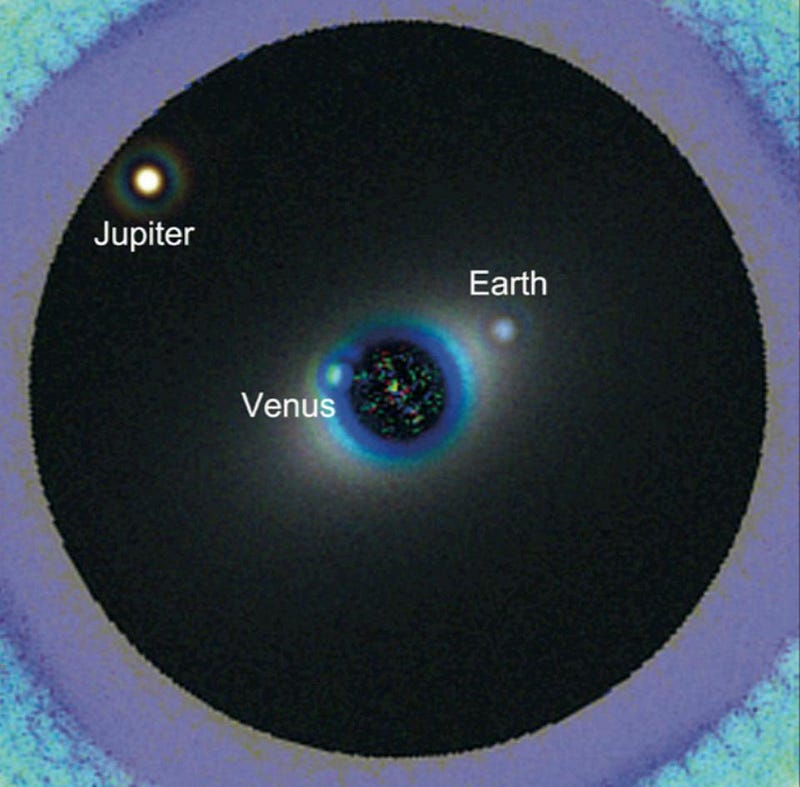
But whether it is or not, we don’t want to have to wait until more than a decade from now to find those answers. Direct imaging of these worlds might not be on the immediate horizon, but NASA’s James Webb Space Telescope, slated to launch later this year, can teach us about an exoplanet’s composition in a different way: through what we call transit spectroscopy.
When an exoplanet passes in front of its parent star’s disk, most of that light gets blocked by the disk of that planet. But — just like the Moon turns red during a lunar eclipse, because sunlight filters through the Earth’s atmosphere, red more efficiently than blue, and lands on the Moon — a small portion of the light that gets through will have certain wavelengths of light absorbed more than others.
By breaking the observed starlight during a transit into its individual wavelengths, and then comparing that with the spectrum of the star while there is no transit, we can measure the relative atmospheric contents of whatever gases we like: oxygen, nitrogen, methane, ammonia, water vapor, carbon dioxide, etc.
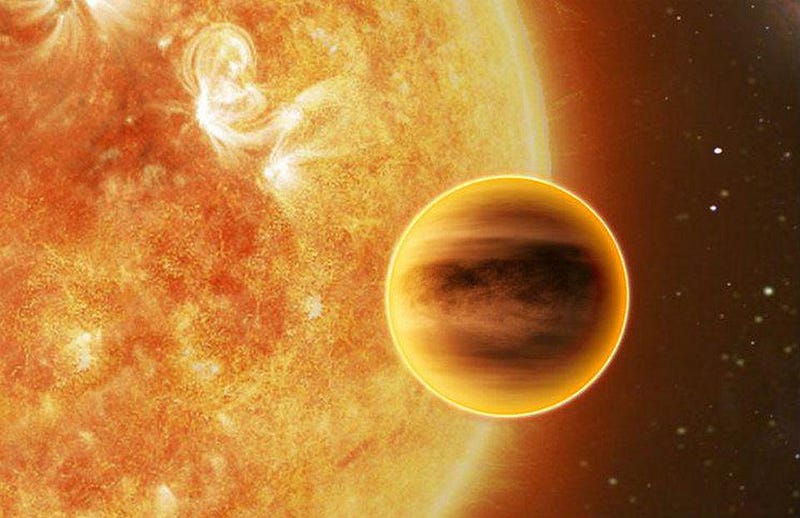
The bigger your planet is relative to the star, the more light it’s going to block, and the easier it is to detect its atmospheric signatures. We don’t think that NASA’s James Webb Space Telescope won’t be able to measure the atmosphere of Earth-sized planets around Sun-like stars, but it should be able to measure super-Earth atmospheres around Sun-like stars.
It’s going to be very difficult to know if an exoplanet is inhabited, as all we expect to get from these indirect measurements are “hints” towards the possible existence of life. However, the question of whether the exoplanet we’re looking at has a surface or not — whether it’s a super-Earth or a mini-Neptune — might be answerable as soon as the James Webb Space Telescope observes it.
The key insight — which the new paper details — came from thinking about the atmospheres of two very, very different worlds in our own Solar System: Jupiter, the largest planet of all, and Titan, the giant moon of Saturn, which is the only moon in the Solar System with a thicker atmosphere than Earth’s.
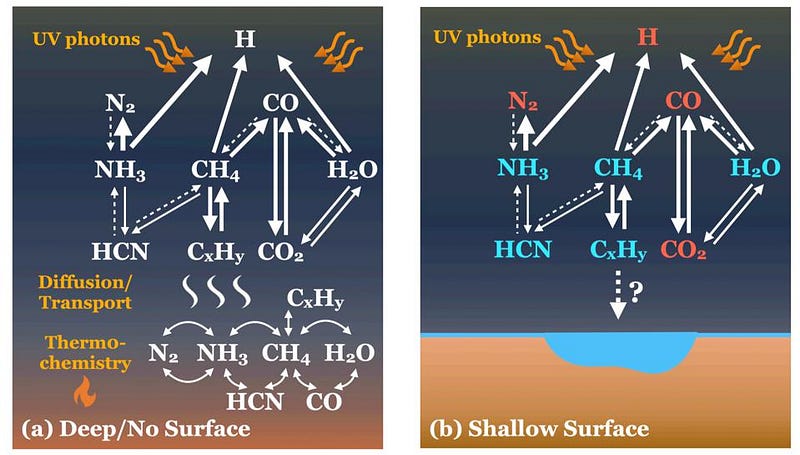
Think about one simple molecule: ammonia, which is nitrogen-based. Both Jupiter and Titan have small but detectable amounts ammonia in their atmospheres. In the upper atmospheres of both worlds, photochemical reactions from the Sun destroy ammonia, creating nitrogen gas and hydrogen. If you look at Jupiter, you see almost no nitrogen gas but plenty of hydrogen and ammonia, while if you look at Titan, you see plenty of nitrogen gas but almost no hydrogen or ammonia.
Why?
Because Jupiter has a thick atmosphere, and the deeper down you go, the hotter it gets. The denser nitrogen can sink down to the lower layers, while the lighter volatiles can rise up and repopulate the upper atmosphere. Meanwhile, Titan has a thin atmosphere, meaning that the temperature gradient between its surface and upper atmosphere is small. Over time, the ammonia gets depleted and not replaced, leaving the nitrogen to just hang out. By measuring the ratios of something as simple as nitrogen to ammonia, we can determine, from photochemical modeling, whether there’s a thin atmosphere — and hence, a surface — or an atmosphere so thick that there’s no evidence for a surface at all.

It turns out, according to this novel scientific result, that it isn’t just ammonia/nitrogen that’s sensitive to the existence of and depth to the planetary surface below. Other molecules — methane, ethane, water, carbon dioxide, carbon monoxide — can also be present, allowing for interesting molecules (like hydrogen cyanide) to form where multiple species existed initially.
Just by measuring the chemical composition of the upper atmosphere of an exoplanet, which we can do for many so-called super-Earth worlds with James Webb’s capabilities, we should be able to learn how thick its atmosphere is. Whether it has a shallow surface (like Earth), an intermediate surface (like Venus), or a deep surface (like a gas giant) will all govern the ratios of gas that we’ll observe.
These are observations that the James Webb Space Telescope can make immediately upon beginning science operations, and it could tell us — even though it’s indirect information — which of these larger-than-Earth exoplanets really are super-Earths, with shallow atmospheres and nearby surfaces, and which ones have atmospheres that are so deep that their surfaces are all but undetectable.
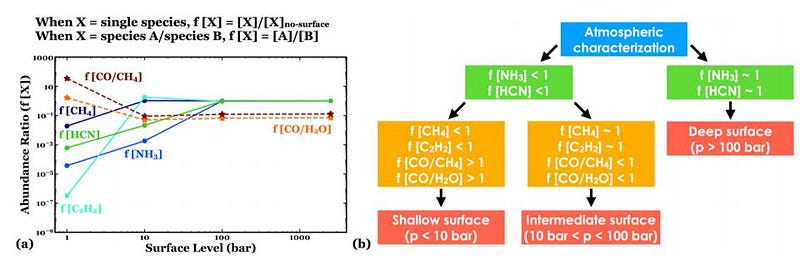
Ever since the first exoplanets were discovered, the ultimate dream has been to find those cosmically rare worlds like our own: the ones where life exists. As our technology progresses, we can begin to measure properties of these worlds that help us understand how suitable for life they are. At present, we can know their mass, radius, and orbital parameters, but we can’t tell if they have surfaces, thin or thick atmospheres, or suitable conditions for life.
With the James Webb Space Telescope and the transit spectroscopy technique, however, we can take an enormous leap forward: we can determine which of these larger-than-Earth exoplanets are mini-Neptunes with enormous, gaseous envelopes, and which ones really are super-Earths, with thin atmospheres and solid surfaces.
In the quest for life beyond Earth, every piece of information matters. Remarkably, a novel study has shown that just by measuring the atmospheric concentrations of various species of gas — something that James Webb will be able to do — we can learn, at long last, if any of the exoplanets we’ve discovered really are super-sized versions of Earth.
Send in your Ask Ethan questions to startswithabang at gmail dot com!
Starts With A Bang is written by Ethan Siegel, Ph.D., author of Beyond The Galaxy, and Treknology: The Science of Star Trek from Tricorders to Warp Drive.





